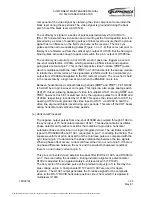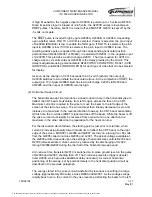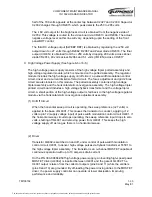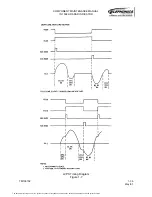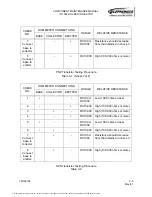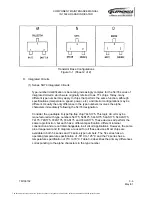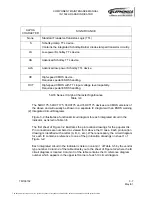
COMPONENT MAINTENANCE MANUAL
IN 1502H RADAR INDICATOR
TM109102
1-37
May/01
Frequency is minimum with a light load and the line voltage high. It can be seen from
the figure that Q5001 and Q5004 produce the positive current waveform when
triggered by Q5005; and Q5002 and Q5003 produce the negative waveform when
triggered by Q5006. The transistors shut off when current decreases to zero.
Because of this feature, the LVPS is relatively noise free, without the transients
present in other designs in which the power transistors are switched off when fully
conducting.
Note that, in Figure 1-7, current reverses direction after reaching zero. This is
because the diodes in the circuit (CR1/CR4 and CR2/CR3) are allowed to conduct
when the transistors turn off. Returning energy to the 28 volt source in this manner
increases the efficiency of the power supply.
(4) Current Limiter
The secondary of T5003 provides current sensing via R5003 and diodes CR5029 and
CR5030. The top of R5003 is connected to the negative input (pin 9) of U5002B,
which is the current limiter. This operational amplifier compares this level with a 5 volt
level at its positive input (pin 10). The 5 volts is obtained by di12 volts down
through R5021 and R5024. As current increases to an excessive level, the voltage at
pin 9 also increases, causing a reduced output at pin 8 of U5002B. This output is
applied, via CR5008 and CR5011, to pin 13 of VCO U5003 to control frequency. The
reduction in voltage causes the VCO to slow down. The lower frequency results in
less total current through T5003.
This circuit senses an overload, which may be caused by a short circuit condition
somewhere in the indicator, by monitoring the 5 volt line for a significant reduction in
the 5 volt level. Under normal conditions, pin 10 of U5002B is biased at +5 volts, as
already explained. However, connected to the junction of R5021 and R5024, through
the relatively small resistance (compared with R5024) of R5027, is the 5-volt feedback
line. Thus, in the event that the 5 volt output of the LVPS drops significantly, the low
resistance of R5027 allows the reduction to be sensed by U5002B, biasing its positive
input at a lower level. This means that the current sensed at T5003 need not be nearly
as great as under normal conditions in order for U5002B to drive the VCO at a lower
frequency. In the worst case, with the 5 volt line shorted to ground, only the slightest
current flowing through T5003 will be sufficient to keep the VCO operating at
minimum frequency, with zero volts at its frequency-control input.
(5) Voltage Regulator Circuit
Operational amplifier U5002C monitors the 5 volt feedback line and adjusts the
frequency of the VCO to prevent variations in the 5 volt output of the LVPS. The +5
volts is divided down through R5031, R5030 and R5028 to obtain the voltage that is
sensed at the negative input (pin 6) of U5002C. Potentiometer R5031 is adjusted to
set the 5 volt level. The second input of U5002C is biased with the precision 2.5 volt
output of U5006. Thus in the event that the +5 volt output of the LVPS increases for
any reason, the output (pin 7) of U5002 will pull the frequency control input of the
VCO low to reduce the frequency. Similarly, any reduction in the 5-volt output will
cause the frequency to increase.
The document reference is online, please check the correspondence between the online documentation and the printed version.



